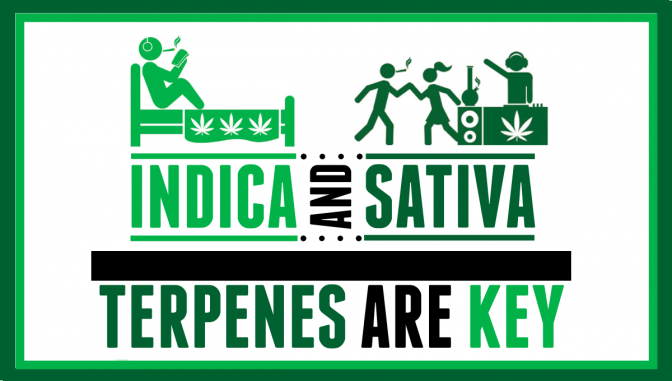Debunking Indica and Sativa: What You Really Need to Know About Marijuana

Since the advent of widely available scientific testing, many long-held assumptions about cannabis are being questioned or even dismissed. With testing for THC and CBD, and molds, pesticides and other foreign elements, many cannabis consumers now know far more about what they’re consuming than ever before.
Terpene testing began in earnest a few years ago, and the scientific data available to consumers, and what this data indicates, has become increasingly important. One of the most significant new ideas derived from this new data is that common notions about indica and sativa strains are not as indicative of their effects as a strain’s particular combination of THC, CBD and terpenes.
Since the 1970s, most cannabis aficionados have grouped herb into two main categories: indica and sativa. Defined by plant morphology, indicas are generally short, stocky plants with a close internodal distance and a wide, often overlapping leaf structure, while sativas have a longer, looser bud structure with lanky, thin leaves.
The 38th parallel is the dividing line between where the two different cannabis species traditionally grow. North of this line, in countries like Afghanistan and Pakistan, squat plants primarily used for hash making are known as indicas. South of this line, in countries like Mexico and India, tall plants, commonly reaching 14 feet or more, are known as sativas. One theory holds that all cannabis plants started as sativas, and as the plant migrated geographically, it simply adapted to its new climates and conditions.
Each species is described broadly as having particular effects: Indicas are said to be heavy and sleep-inducing, with a pronounced “body high,” while sativas are described as having an up or“head high,” and also the potential to induce anxiety. For almost three decades these simplistic definitions have been widely believed and disseminated.
One of the top scientific experts on cannabis, Dr. Ethan Russo, is best known for his pioneering work with GW Pharmaceuticals in developing the first commercially available cannabis medicine in almost 80 years, Sativex. More recently, he conducted an extensive study of terpenes and their effects, and reached some pretty surprising conclusions.
“The sativa/indica distinction commonly applied in the lay literature is total nonsense and an exercise in futility,” Dr.Russo said in 2015, of the traditional classifications. “One cannot in any way correctly guess the biochemical content of a given cannabis plant based on its height, branching or leaf morphology.”
With this one statement, he basically dismissed three decades of herbal folk wisdom. Dr. Russo’s work is changing the way we look at and describe cannabis; he posits that terpenes play a far more important role than commonly thought in determining how a particular strain affects an individual.
 “The sedation [effect] of the so-called indica strain is falsely attributed to CBD content, when, in fact, CBD is stimulating in low to moderate doses,” Dr. Russo emphatically contends. “Rather, sedation in most cannabis strains is attributable to their myrcene content—a monoterpene with a strongly sedative couch-lock effect. In contrast, a high limonene content, common in citrus peels, will be uplifting on mood, while the presence of alpha-pinene can effectively reduce or eliminate short-term memory impairment classically induced by THC.”
“The sedation [effect] of the so-called indica strain is falsely attributed to CBD content, when, in fact, CBD is stimulating in low to moderate doses,” Dr. Russo emphatically contends. “Rather, sedation in most cannabis strains is attributable to their myrcene content—a monoterpene with a strongly sedative couch-lock effect. In contrast, a high limonene content, common in citrus peels, will be uplifting on mood, while the presence of alpha-pinene can effectively reduce or eliminate short-term memory impairment classically induced by THC.”
The effects of terpenes have been known for years. The entire perfume industry is built around concentrating and combining specific terpenes in order to make wearers more attractive and compelling, and the up lifting effects of limonene and pinene are employed by the cleaning products industry to make their products more enjoyable to use. This also applies to the most popular strains—from the limonene lift of Tangie to the pinene punch of Jack Herer—but most cannabis users don’t really know it yet.
If it were up to Dr. Russo, we would most certainly do away with the current descriptors. “I’d strongly encourage the scientific community, the press and the public to abandon the sativa/indica nomenclature, and insist that accurate biochemical assays and terpenoid profiles be available in both the medical and recreational markets,” he says. “Scientific accuracy and the public health demand no less than this.”
Given the attachment of cannabis breeders and consumers to the indica/sativa designations, any new system is going to take a while to become widely accepted. But the change has begun: At better-quality dispensaries, terpene profiles are available, and employees are increasingly savvy to these differences.
If you enjoyed this Freedom Leaf article, subscribe to the magazine today!

